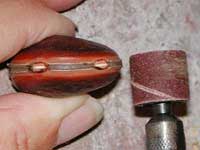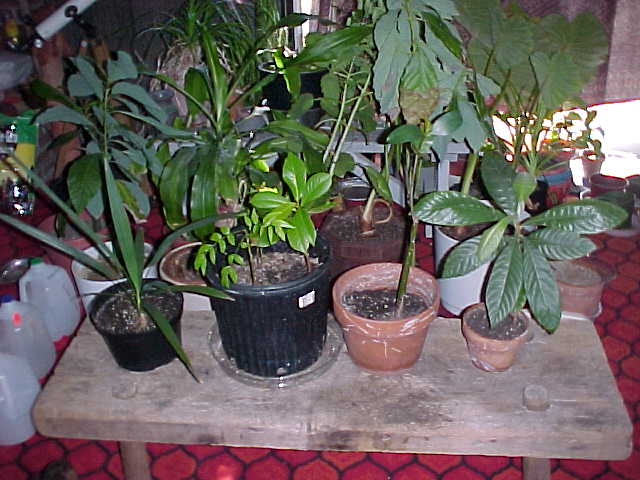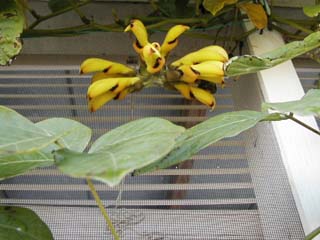|
You can sprout sea-beans, but
keeping them alive outside in even a mildly cool winter climate is difficult. If you can keep them
inside (away from temperatures below 50 degrees F (10 degrees C), they will survive, but
most of them grow so fast that they can easily take over your home.

Mucuna albertisii(?)
being sanded |
To grow any sea-bean, fresh water needs to reach the
living seed inside the protective casing. For hard sea-beans, like the true sea-bean or
sea-heart, and the Mucuna or Hamburger Bean, you must first create a hole in the outer shell to let water in. This can be done by sanding the seed in one spot until a hole appears, or using a Dremel tool to grind away a spot or cut a small portion of the seed coat away. Grind until the internal "meat" shows thru, but not damaged. The holes shown are "starter holes"... I prefer to cut away all of the hilum between the two holes shown! Let the water in! For Mucuna, avoid the area at either end of the hylum, as that is likely where it will sprout from. Put the sea-bean in a shallow dish of fresh water and leave it for several hours (perhaps 5-6 hours). The bean will swell as it absorbs water. Remove the swollen seed from the water, plant it in warm, moist soil of any type and wait for it to sprout.
Webmaster's note:
Presently, I make a MUCH LARGER cut along the hilum, at least connecting the two small holes shown; additionally, I make the hole wider. After soaking for a few hours in rainwater, I squeeze the seeds, underwater, to get air bubbles out and let more water into the seed... hopefully to the meristematic area to enhance sprouting! |
In nature, this "scarification" of the seed might be accomplished by some rodent seeking a meal by chewing through the outer shell of these seeds, much like a squirrel eating an acorn. Obviously, if the entire seed is eaten, the seed is history. Some seeds may survive to sprout if a hole is eaten into the hull, little to none of the inner "meat" is consumed, and the seed is dropped and forgotten. Periodically, you may find a hard-coat seed with small teeth marks indicating a half-hearted attempt to access the "meat" inside the seed.
How long does that
take?
The time varies, but usually the sea-bean will sprout within two weeks, sometimes 4 weeks (patience!). Of course, the time varies depending on the seed species, temperature, and seed viability. Some sea-beans may be non-viable and will never sprout, so you may want to try sprouting a few at a time. Also, variabilty improves results: cut holes different places in the seeds; let the bean soak for different lengths of time, and then plant them at different depths in the soil, etc.
Then what?
After the seed sprouts, plant it in good potting soil, give it direct sunlight, and continue watering. During early growth periods, some Hamburger bean sprouts may grow over 2 inches a day!
|
|

Photo: Maureen and Stan Zerkowski
|
IT'S ALIVE!
The plants shown here were sprouted from some "soft" seeds ("corkies") found at Cocoa Beach, Florida.
On the bench from left to right are a
(a) palm of undetermined species, a
(b) Hog Plum (Spondias mombin and
(c) Tropical Almond (Terminalia catappa) in the same large pot, a
(d) Red Mangrove (Rhizophora mangle), and a
(e) Loquat Tree (Eriobotrya japonica)
which is grown in Florida and native to China.
| |
Sea Purse, Dioclea reflexa
Because of Cathie's knowledge, I have managed to start and grow several different sea beans.
|
Early in spring I took a healthy looking Hamburger Bean (Mucuna sp.) bean and rubbed one side of it on a rough concrete block until I wore a small hole in it,then I put it in a small glass of water for a couple days, then I planted it in a small clay pot filled with potting soil and kept it moist for a little more than a week when I saw a small plant start to emerge. |

Mucuna sp. Photo: William Pope |
At this time I took it down from our home in Arkansas to our Beach place on the Gulf in S.W. Louisiana, where I planted it in a protected spot by our screened porch. There it really took hold and started climbing all over it, One day in November I noticed a small bud. Shortly later there were several buds that soon turned into flowers.
by: William E. (Bill) Pope, Dec. 15, 2001
|

![]()


